Clancy Tucker's Blog, page 22
April 4, 2022
25 May 2022 - THE BIRTH OF ALCOHOLICS ANONYMOUS

THE BIRTH OF
ALCOHOLICS ANONYMOUS
G'day folks,
The last thing America’s “Doctor Bob” would have wanted is for anyone to toast his success – even though it was considerable. He himself took his last drink on June 10 1935 – a glass of beer – and one of the best-known self-help groups in the world, Alcoholics Anonymous, began its journey.
Born Robert Holbrook Smith at Vermont in 1879, he graduated as a medical doctor from Dartmouth College in New Hampshire at the age of 21. But he had started drinking and became known among students for being able to down a whole bottle of beer without his Adam’s apple moving.
After Dartmouth Smith enrolled in medical school at the University of Michigan and then attended the Rush Medical School in Chicago to complete his training. But his drinking had become compulsive and was affecting his professional medical competence.
He thought a change of air might help and he moved to Akron, Ohio. There he went into private practice as a surgeon specialising in colorectal surgery. And he married his high school sweetheart, Anne Robinson Ripley.

But Smith was drinking heavily again and according to one report he could not operate on a patient without a few drinks first. Over the next 17 years, he attended over 12 different sanitariums and hospitals in attempts to get sober.
No solution to the problem presented itself until in 1935 Smith met Bill Wilson, a businessman from New York who had faced the same struggle for many years. The two men formed an immediate bond and began searching for ways to solve their joint problem.
They became certain that alcoholism could only be conquered if fellow drinkers offered their support. And that could work only if people shared their fight anonymously. So, with the first self-help group set up in Akron, Smith became “Doctor Bob” and Wilson took the name “Bill W”.
And when Smith drank his last glass of beer on June 10, 1935, with Wilson as a witness, this is generally seen as the official founding date for Alcoholics Anonymous. Smith was sober from then until he died from colon cancer in 1950, aged 71.
Alcoholics Anonymous was and still is by far the best-known self-help group in the world. The organisation has never attempted to keep formal membership records but it is estimated that the number of people involved globally exceeds two million.

Clancy's comment: My father was a member for 35 years!
I'm ...


April 3, 2022
24 May 2022 - BIGGEST BANK ROBBERY IN FRANCE

BIGGEST BANK
ROBBERY IN FRANCE
G'day folks,
Albert Spaggiari, the mastermind behind the biggest-ever bank robbery in France, died leaving no clue as to the whereabouts of the stolen millions.
Spaggiari, born in 1932, was a tearaway, constantly in trouble for stealing. His father died when he was three and his mother, who ran a lingerie shop, quickly remarried, but the boy hated his stepfather. He left home at 17 to join the Parachute Regiment, which was fighting Ho Chi Minh’s communist army in Indochina.
Spaggiari was a tough soldier, wounded twice and decorated for bravery. But his old weakness resurfaced and in 1953 he was arrested after breaking into a milk bar in Hanoi to steal the takings. He was sent back in irons to France and jailed.
By the late 1960s Spaggiari seemed to have turned over a new leaf, married a nurse and moved to the South of France where he opened a photography shop in Nice. His charm and talent soon put him in increasing demand for society and other weddings.
But he longed for action and he had itchy fingers. And when he learned that the sewers of Nice ran close to the walls of the Société Générale bank, plans for a daring robbery began to form in his mind.
First, as a precaution, he rented a safety box in the bank's vault and planted in it a loud alarm clock set to go off at midnight. Spaggiari wanted to make sure there were no acoustic or seismic detection alarms to spoil his plans.
He need not have worried. Like the owners of the Titanic, who thought the ship unsinkable, the bank thought its vault was impregnable.
Next he recruited a gang of villains from Marseilles who headed into the sewers. For two months in the summer of 1976 they waded each night through human waste, digging an eight-meter tunnel which Spaggiari demanded was shored up as well as a mine shaft.

On the Friday night of the three-day Bastille Day weekend they broke through into the vault, sealed its door shut from the inside with a welding gun, and broke open 371 safety deposit boxes before leaving on Monday morning.
The bank did not know what was in the boxes, so the value of the haul would never be known. Estimates ranged from 30 million to 100 million francs in cash and jewels.
When locksmiths brought in by the astonished bank managed to open the door they found deposit boxes scattered across the floor, the remains of meals eaten by the gang, and a message painted on the wall: “Sans Armes, ni Violence, ni Haine” (without weapons, violence or hate).
A few weeks later, acting on a tip-off, the police arrested one of the thieves who named the entire gang, including Spaggiari. He was on a trip to the Far East accompanying the Mayor of Nice as a photographer and was arrested when the returning plane touched down.
At his trial, Spaggiari asked to see the judge in his chambers. There, he suddenly ran to a window, flung it open and jumped out. “Au revoir,” he shouted with a wave, then roared away sitting on the back of an accomplice’s motor cycle. The French police never saw him again.
In his absence the judge gave him a life sentence. Spaggiari spent the rest of his days drifting between South America and Europe and is believed to have returned to France occasionally to see his wife. When he died of lung cancer in 1989 he had been living in Italy under a false name for a number of years.
In 2008 a French biopic of Spaggiari, "Sans arme, ni haine, ni violence", was released in the cinemas. It portrayed him as part comic fantasist and part daring thief, marooned by a hotel pool in Argentina.
Spaggiari wrote a book about the robbery in 1977, translated into English as “Sewers of Gold.” Another book, “The Heist of the Century” by French journalists René-Louis Maurice and Jean-Claude Simoën was given a partial re-write by English thriller author Ken Follett.

Clancy's comment: Mm ... I wonder where the money went?
I'm ...


4 April 2022 - ELEPHANT NATURE PARK, CHIANG MAI, THAILAND

ELEPHANT NATURE PARK
- CHIANG MAI, THAILAND -
G'day folks,
Thailand's distressed elephants find peace at this Chiang Mai sanctuary.Set in Thailand’s Chiang Mai province, Elephant Nature Park provides a sanctuary to rescued elephants from around the country.
Originally founded in 1990, Elephant Nature Park is roughly 60 kilometers from Chiang Mai city, tucked away in the picturesque hills of Northern Thailand. Serving as a rescue and rehabilitation center for elephants from around the country, Elephant Nature Park is—simply put—the ethical way to enjoy the company of a pachyderm when in Asia.
In Thailand, elephant populations have decreased significantly from 100,000 a century ago to now a measly 3,000 estimated elephants remaining. The decline in elephant numbers is namely due to the animals being used for the tourism and logging industries, which subjects these magnificent creatures to harrowing abuse.


For tourists, riding an elephant or purchasing a painting from a pachyderm may seem harmless enough, but it is the “training” techniques used to have the animals perform such feats that are cause for concern. Mahouts—a term for men who work with elephants in Southeast Asia—often subject their animals to barbaric forms of physical abuse to intimidate, scare, and ultimately break the spirit of the elephant.
At Elephant Nature Park, the rescued elephants who arrive at the sanctuary can often come with broken bones, psychological issues, and baring the scars of years of abuse. The silver lining is Elephant Nature Park fights to save these animals and give them a stress-free environment where volunteers can spend time with the elephants in an ethical way.
From feeding the elephants copious amounts of watermelon to walking alongside them as they meander down the river, to simply watching them play in the mud, Elephant Nature Park puts the focus on the wellbeing of its animals. In short, a visit to this sanctuary is how animal tourism should be: putting the animal first.

Clancy's comment: The most revered animal in Thailand.
I'm ...


April 2, 2022
23 May 2022 - EVERY DAY IS CHRISTMAS ON THIS STREET

EVERY DAY IS CHRISTMAS
ON THIS STREET
G'day folks,
Every day is like Christmas on this street where the traditional Neapolitan nativity scene comes to life.The center of Naples is marked with many narrow pedestrian roads, but Via San Gregorio Armeno, also known as Via dei Presepi (Presepi Street), stands out. The street is completely full of shops dedicated to the traditional Neapolitan presepio, the Christian nativity scene. Almost every figure and decoration found here is handmade by local nativity scene artisans.
The tradition of the presepio (also spelled presepe) goes back to the Middle Ages, when Saint Francis of Assisi created the first nativity scene in 1223, depicting the infant Jesus in a manger. But it wasn’t until the 16th century that it started to become common in Naples to put nativity scenes in churches and houses before Christmas. During the 17th and 18th centuries the nativity scene became more widespread and began incorporating fine handcrafted figurines. Many presepi from this era that are true works of art can be seen in churches and palaces in Naples and the surrounding region.
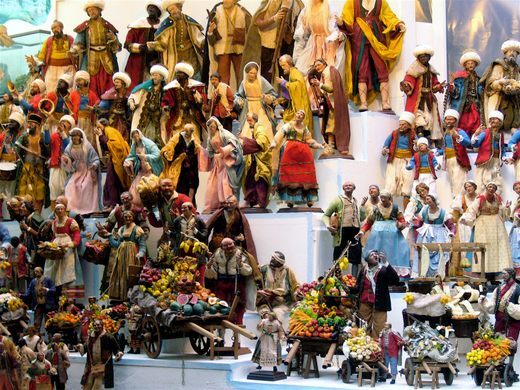
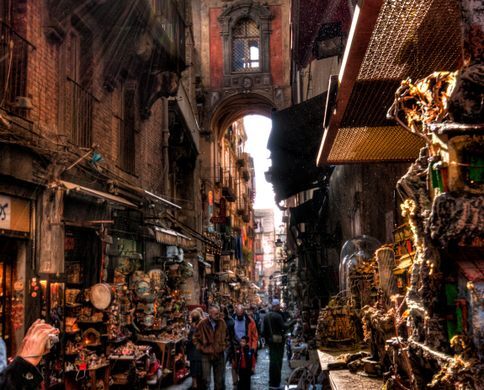
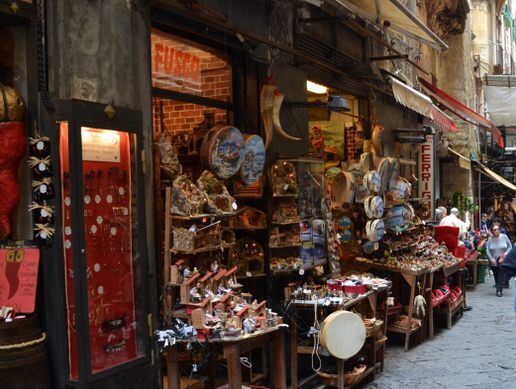
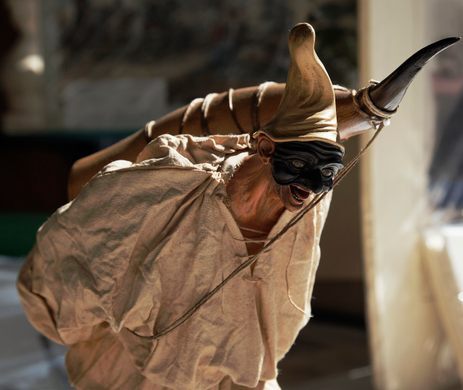
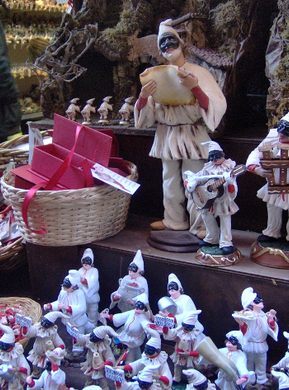
Now, besides the classical figures of the presepio—the baby Jesus, Mary, and Joseph—all kinds of statuettes can be found on Presepi Street, from pizza makers to animals, and especially caricatures of celebrities like politicians, singers, TV personalities, and athletes (mostly soccer players), in a fusion of sacred and profane. The figures are often small enough to place in a nativity scene, but sometimes even life-size statues can be found. Also on offer are various decorations and structures crafted for nativity scenes, from little household objects to full houses, as well as trees, mountains, and evens rivers and waterfalls with real water.
Many characters or places have hidden meanings rooted in the long tradition of the presepio. Different merchants represent different months of the year, and the river represents the mythical river Acheron that marked the border of Hell. Statues of the classical masked character of Pulcinella that has represented Neapolitan people since the 16th century are also very common, along with other symbols of the local culture, such as the little horn amulet worn to protect against bad luck.
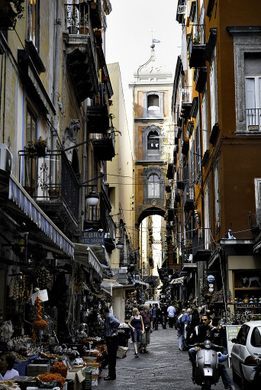
Clancy's comment: This is an enchanting part of Naples.
I'm ...

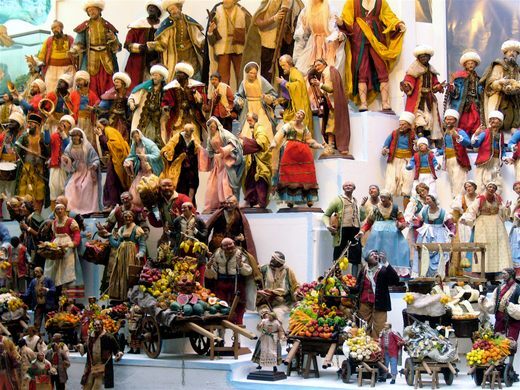
March 31, 2022
22 May 2022 - THE SUNKEN CEMETERY - CATARMAN, PHILIPPINES

THE SUNKEN CEMETERY
- CATARMAN, PHILIPPINES -
G'day folks,
A cemetery and the town it served sinks beneath the sea during the volcanic birth of Mt. Vulcan.There are no flowers or gravestones to mark the resting places of the lost citizens of Camiguin – only a giant cross rising up out of the water to mark where this place of rest once was.
In the 1870s, a volcano near this place erupted and caused the cemetery along with the capital city surrounding it to sink below sea level. In order to commemorate this place of loss, a looming cross was built in remembrance. Visitors all over the Philippines and the world come to admire this man-made marvel filled with legend and enchantment.

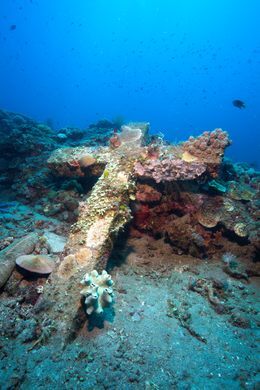
Some say a feeling of loneliness will hit you once you see this structure standing all alone in the middle of the sea. A place of reverence and reflection, the site is accessible by boat and visitors can stand on its small base while it remains above water. Many take the small boat ride in order to take photos and soak in the view of Mt. Vulcan, the volcano that sacrificed the people of Camiguin to the sea when it came into being.
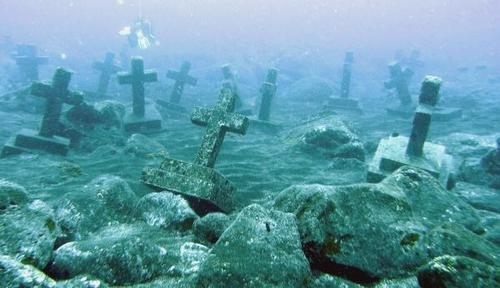
Clancy's comment: A sad epitaph, eh?
I'm ...


March 30, 2022
21 May 2022 - BUA TONG STICKY WATERFALL, THAILAND

BUA TONG
STICKY WATERFALL
- THAILAND -
G'day folks,
Here, you can walk up one of Thailand’s naturally non-slip waterfalls.
Thailand is full of pretty waterfalls, some big, some small, some in-between. And like most waterfalls in the world, and rivers in general, the wet rocks nearby tend to be slippery, often treacherously so. But one waterfall, Bua Tong, stands out from the crowd for offering a surprising amount of traction.
Bua Tong Waterfall is a small, picturesque waterfall whose milky-white waters tumble through the surrounding jungle. It falls over three tiers, at an angle of about 45 to 50 degrees, over rocks that have a strange bubble-like appearance. If this were any normal waterfall, it would be great to slide down the slippery rocks. But people don’t come to slide down Bua Tong, known as the Sticky Waterfall by locals. Instead, they walk up it.


The waterfall is fed by a calcium-rich spring at the top, which plunges down over the rocks. Over time, mineral deposits have given the rocks a pumice-like texture. So rather than being perilously slippery, the wet rocks along the Bua Tong Waterfall are actually quite rough and therefore easy to walk along—and up—even when wet.
You can walk barefoot over the “sticky” rocks, which are rough but not so rough that they’ll cut or hurt your feet. You still need to watch out for some sneaky rocks that offer less traction and are therefore potentially slippery. These tend to be grayer in color than the surrounding rocks.
The waterfall is a popular spot among locals, especially on the weekend, but is still quite light on tourists. So you can normally make the ascent without any crowds, enjoying the refreshing water and the jungle scenery as you walk up the Sticky Waterfall. And if you feel like walking some more afterward, there’s a trail from near the top of the falls to Nam Phu Chet Si, a sacred spring and shrine in the jungle. Its supposedly healing waters contain the same calcium carbonate that made Bua Tong sticky.

Clancy's comment: Amazing, eh?
I'm ...


March 29, 2022
20 May 2022 - INTERNET ANTENNAS OF CHRIST THE KING - POLAND

INTERNET ANTENNAS OF
CHRIST THE KING
- POLAND -
G'day folks,
This towering statue of Jesus provided internet to the surrounding area.The Christ the King statue in Świebodzin, western Poland, is considered by some to be the tallest statue of Jesus in the world. It also once had internet antennas on its head, a feature that remains something of a mystery.
Poland’s Christ the King statue was completed in 2010, at a cost of around $1.5 million. Upon its inauguration, some 15,000 Christian pilgrims and tourists came to see the monumental unveiling.
The statue itself is 108 feet tall, but if you include the mound it sits on and the golden crown on its head, its total height is 167 feet. This would make it the tallest statue of Christ in the world, surpassing Cristo de la Concordia in Cochabamba, Bolivia (133 feet) and Rio de Janeiro’s Christ the Redeemer (125 feet).
The statue was financed entirely through donations from the town’s 21,000 residents, along with other outside advocates of the project. Not all residents were happy, however, quietly and often anonymously arguing that the money would have been far better spent on new schools, hospitals, or roads. Many were wary of speaking out in fear of provoking the wrath of the church in what is a very Catholic town in a particularly devout country.
More controversy arose 10 years after the statue’s completion. In 2018, the Polish tabloid Fakt 24 noticed that antennas had been installed on top of Jesus’s head, tucked inside his 9.8-foot-tall golden crown. The agency sent up a drone for a better look at the equipment and confirmed that the antennas were for broadcasting an internet signal.


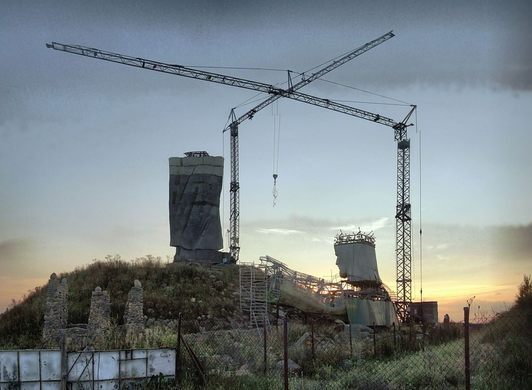
Still, no one seemed to want to provide a clear answer regarding the statue’s divine broadcasting abilities. Reporters contacted the Divine Mercy Parish, the religious body that oversees the statue, asking if they had rented out Jesus’s head. A spokesperson denied all knowledge and stated that Christ’s crown was not being leased to anyone.
The same reporters then found a source at an unnamed internet provider, who claimed that the antennas were placed there by request of the parish. According to the report, the source stated that the local church needed the network for a video surveillance system, and that the agreement was completely legal. The source also said that the signal was being relayed to other clients in the area.
Beyond that, it remained a mystery. Was the head of Christ the King being monetized in the pursuit of better wi-fi? Was it not profane to place antennas on the head of Jesus Christ? Opinions vary, but one thing is for certain: The towering statue is an ideal spot for an antenna array, providing an unobstructed view across the landscape and far-reaching internet coverage.
Unfortunately, all that is a thing of the past. The local bishop, when he learned about the antennas, ordered their removal because many faithful found them offensive. They were removed on May 9, 2018.

Clancy's comment: I'd have thought this was a resourceful use of a statue.
I'm ...


March 28, 2022
27 May 2022 - UMBRELLA STAIRCASES OF AMMAN

UMBRELLA STAIRCASES
OF AMMAN
G'day folks,
Here, you will find an oasis of shade and color amidst the bustle of the old city.
Downtown Amman, Jordan, has always been known for its staircases. According to legend the city was built on seven hills, although the present-day reality is that there are many more than seven!



In this hilly place, the daily life of residents and visitors very often revolves around finding pedestrian staircases to shortcut between the vertically stacked neighborhoods of central old Amman. It can take more than an hour to go from Rainbow Street to the Grand Husseini Mosque by car; but on foot, via the network of staircases, you can make the same journey in just a few minutes.
For many years there has been a tradition of decorating the city with bright graffiti (some of it even commissioned), and this includes many very colorfully painted staircases. A more recent phenomenon, however, is the umbrella-covered staircases: also colorful, shaded, and almost oasis-like amid the heat and bustle of old Amman.
No one seems to remember which was the first, but now there are several umbrellas adorning the stairways throughout the old city. Some are seasonal, others are up all the time. There is one in the gold souks off of King Faysal Street. The most well-known is the staircase that leads up from Prince Muhammed Street up to the Zajal restaurant.
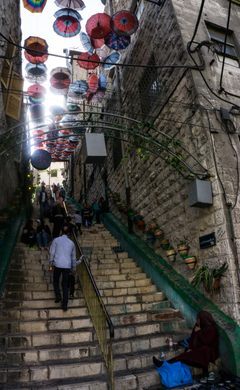

Clancy's comment: Ah, the enchantment of the Middle East.
I'm ...


19 May 2022 - THE GORGEOUS TOWN OF ES-SALT, JORDAN
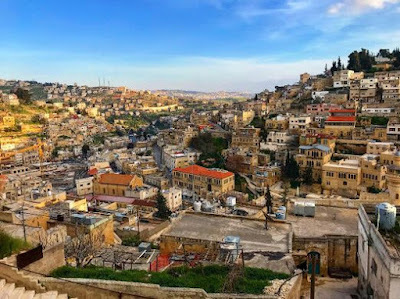
THE GORGEOUS TOWN OF
ES-SALT, JORDAN
G'day folks,
This ancient town is full of stunning Ottoman architecture and streets so narrow trash collection is done by donkey.Just north of Amman, in Jordan’s Balqa Government, is a city that has been inhabited since at least the Chalcolithic period. The ancient town of Es-Salt is home to remarkable Ottoman architecture, the legendary location of the prophet Job’s interment, and streets so narrow and winding that for some residents trash collection is done via donkey instead of vehicle.
Full of gorgeous panoramas and historic structures, Es-Salt is best appreciated by way of a strenuous trek up the historic Harmony Trail. At the end of the ascent stands a striped pink-and-white stone building locally known as al-Qal’a, Arabic for “The Castle.” In fact, it is a mosque and memorial to Ottoman soldiers who died in the vicinity during World War I. Though it requires a long hike, the view of Es-Salt from The Castle is worth the effort. On this peak, you’ll be standing atop layers and layers of history.
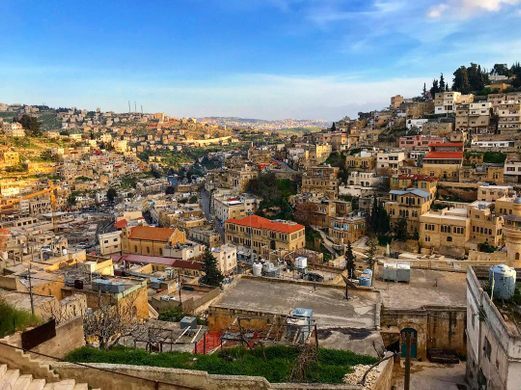
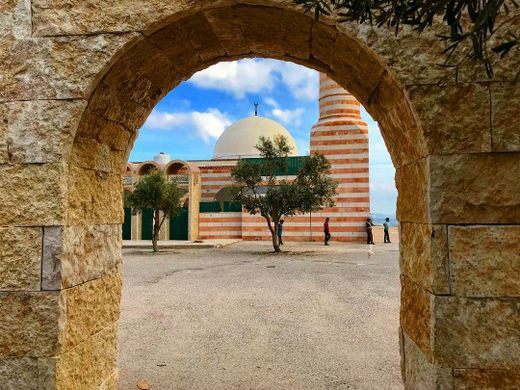
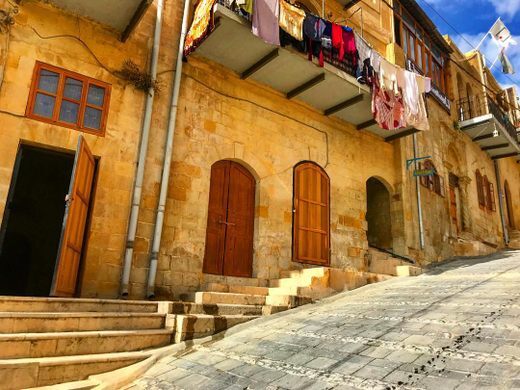
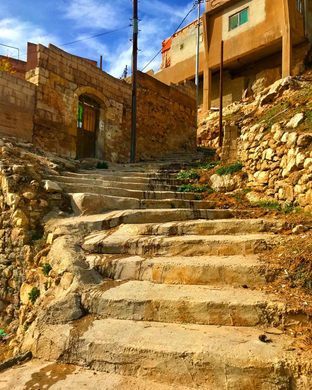

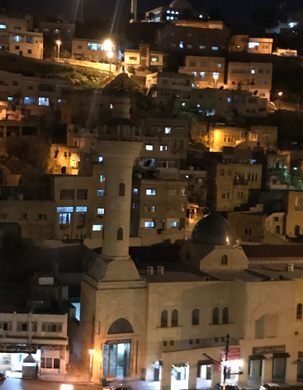

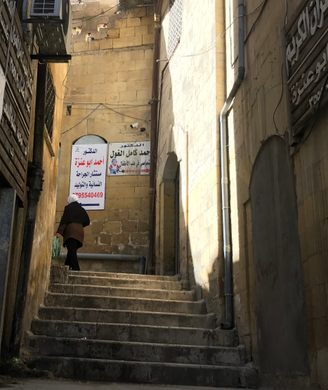
While it was founded by Alexander the Great, there is attestation in both written and archaeological record (some of which is on display at the city’s museum) that the area was previously settled by a Semitic-speaking people. It has seen Byzantines, Ghassanid Arabs, Mongols, Mamluks, Ottomans, Brits, and others pass through—alternatively building, ravaging, repairing, and occupying the city. However, the mark left on the city by the Ottomans has persisted.
Under these Turkish-speaking rulers, Es-Salt was the administrative capital of Jordan, and it is consequently full of stunning examples of Ottoman architecture, characterized by long arching windows and elegantly carved stone. Its style has also been influenced by Nablusi architects, who came from Palestine in the late 19th century. This city boasts the oldest public secondary school in Jordan (visible in the distance from The Castle), which is still in operation. In the days when trade was carried out on foot or by caravan, Es-Salt was an important hub, lying on the path between Amman and Jerusalem.
Es-Salt has historically been a mixed city of Muslims and Christians, as attested to by the presence of numerous mosques and churches distributed among the tightly packed line of houses bordering the winding streets. Of all the churches, Al-Khader, or St. George Orthodox Church, is the most famous. It incorporates a small cave and is covered in ornate paintings of the disciples and of St. George slaying a dragon. Another highlight is the Al-Hammam Road, which runs through a bustling marketplace frequented by locals and whose doors are reminiscent of some of the famous markets in Syria. You’d be hard-pressed to find a better place to visit for an authentic Jordanian experience.

Clancy's comment: Stunning place for a photographer.
I'm ...


March 27, 2022
18 May 2022 - HIDDEN UNDERGROUND IN NAPLES
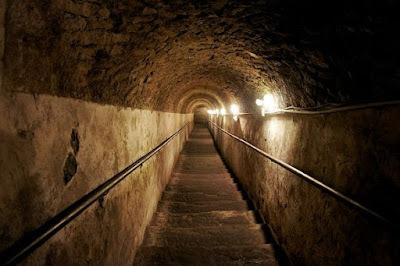
HIDDEN UNDERGROUND
IN NAPLES
G'day folks,
A labyrinth of ancient tunnels hidden below the city holds the ruins of 2,500 years of history.Underneath the ancient city of Naples lies a vast geothermal zone composed of tuff, a volcanic rock. Over the last two-and-a-half millennia, extensive caves and tunnels have been carved out of the tuff, forming a shadow city obscured below the ground.

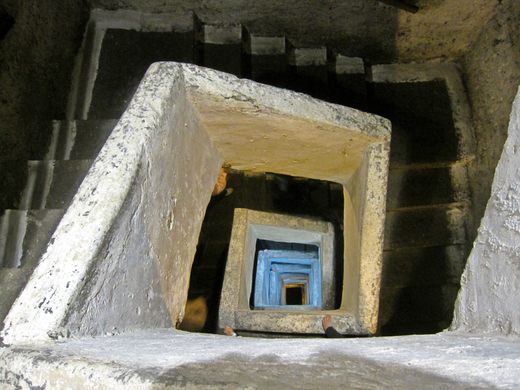
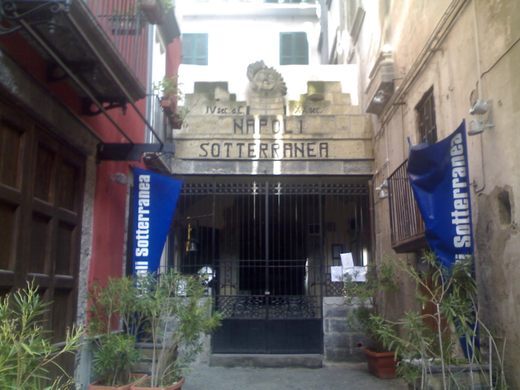
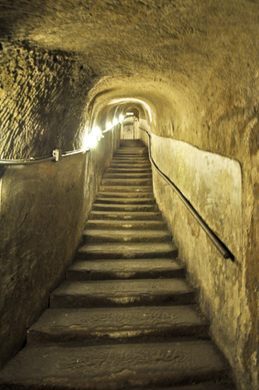


The 280-mile (450-kilometer) subterranean network was formed by the Greeks in the fourth century BC to build what was then named Neapolis, or “New City.” The Romans later used the chambers and pathways to build aqueducts that provided water for many centuries of Neapolitans. As the centuries passed, buildings were constructed on top of previous ancient infrastructure, and the remains of these structures are were hidden deep below the city.
Today, Napoli Sotterranea (Naples Underground) offers a chance to explore this Italian city from a different point of view. Down a long case descending some 120 feet (40 meters) below the earth, aqueducts, sewer tunnels, rainwater cisterns, caverns, catacombs, and pre-Christian hypogea can be found in the tuffaceous cavities, along with roadway and rail tunnels. Some caves that were part of the reservoir are still full of water today. One highlight of the subterranean network is the remains of the Greco-Roman theatre of Neapolis, where the Roman emperor Nero also had his private dressing room.
Many years later, the underground network was used as an air raid shelter during the Second World War, and you can still see forgotten war relics such as weapons and vehicles in the tunnels. More recently, the first Hypogeum Gardens in the world can be found, an experiment to grow various species of plants far from pollution, but also light, in the dark chambers underneath the city.

Clancy's comment: one of my favourite cities.
I'm ...





